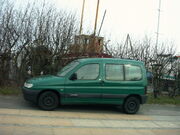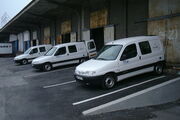m (fixing dead links) |
|||
| Line 103: | Line 103: | ||
* [http://www.batteryvehiclesociety.org.uk Battery Vehicle Society (UK)] which also holds a register of Berlingo Electriques with useful information for all users. |
* [http://www.batteryvehiclesociety.org.uk Battery Vehicle Society (UK)] which also holds a register of Berlingo Electriques with useful information for all users. |
||
* [http://www.electricdriver.co.uk/magazine/content/technical/citroen-berlingo Electric Driver Description] |
* [http://www.electricdriver.co.uk/magazine/content/technical/citroen-berlingo Electric Driver Description] |
||
| − | * [http://www.kfb.se/pdfer/R-00-27.pdf Clean Vehicles with Electric Drive] Final report from the Swedish research, development and demonstration programme on electric and hybrid vehicles 1993-2000 |
+ | * [http://web.archive.org/web/20100813075028/http://www.kfb.se/pdfer/R-00-27.pdf Clean Vehicles with Electric Drive] Final report from the Swedish research, development and demonstration programme on electric and hybrid vehicles 1993-2000 |
{{DEFAULTSORT:Citroen Berlingo Electrique}} |
{{DEFAULTSORT:Citroen Berlingo Electrique}} |
||
Latest revision as of 17:14, 4 September 2014
n

A regular Citroën Berlingo

Battery-powered Citroën Berlingos
The Citroën Berlingo électrique is a battery-powered version of the Berlingo range of vans. It has a 162 V Saft NiCd battery [1], a 28 kW Leroy Somer electric motor [2] and has a maximum speed of 95 km/h (59 mph), with a maximum range of 95 km (59 mi) in typical driving. It is used by the French postal service [1]
Overview
As the van was designed from the outset as a petrol, diesel and electric powered vehicle, the instrumentation and controls are very similar to a petrol/diesel van.
Description
Transmission
The Berlingo électrique is equipped with direct drive transmission. The vehicle is often mistakenly described as having an "automatic" gearbox whereas in reality the very wide power range of the motor when compared with the very narrow power band of an Internal Combustion Engine means that gears are unnecessary. The Berlingo électrique has in effect only one forward gear which serves from 0- 70 mph (110 km/h). The 'gear' stick looks similar to an automatic one but is limited to Drive, Neutral, Reverse and Park.
Ignition operation
The ignition key controls the normal expected functions of accessories, ignition circuit and starting. When the ignition key is momentarily moved to the start position the main traction battery relay is energised (causing a clunk) which allows the accelerator to move the vehicle as normal. The function of the ignition switch is slightly different than regular cars as only the stop light and the handbrake light (if the handbrake is applied) are displayed. On other cars all the indicator lights are shown to check bulb condition.
Instrumentation
The large energy meter display shows remaining energy as a percentage and is surprisingly accurate. The good accuracy is provided by the on board controller monitoring the Amp-hours in and out of the battery rather than the battery voltage. However, the low charge light is operated by the battery voltage. This can mean that the low energy light does not always illuminate at exactly the same percentage charge across different vehicles or even the same vehicle at different times.
Heating
In order to minimise battery usage, a petrol driven heater is fully integrated to vehicle. It typically takes 5 to 10 minutes to warm and provides excellent cabin heating. It takes several minutes for the heater to run down and will therefore continue to operate after the ignition is turned off.
Brakes
Power assisted brakes are supplied as standard. However, because the vacuum supply from the engine in-let manifold that normally supplies the brake servo is not available on an electric vehicle, a dedicated vacuum pump is used. (Typical operation of the vacuum pump is on for 10–15 seconds and off for a couple of minutes).
Power steering
Power steering is supplied as standard. However, because the continuous rotation of the engine is not available on an electric vehicle, an electric motor is used to power a power steering hydraulic pump.
Design quirks
When the very powerful regenerative braking is active the brake lights are not illuminated. This can be disconcerting for other drivers who may not notice the van slowing significant without the help of the brake lights.
The manual does not indicate that removing the charging plug before it is fully charged can illuminate the 'Electrical Fault Light' which stays on until a full trickle charge is performed. This can be quite disconcerting as the manual states the car has to be taken to the dealer to reset the problem. Also, one cannot, or should not, perform a fast charge when it is in this state.
Speed and range
The actual maximum miles per charge is very dependent on the driving style. Specifically the speed. This is because atmospheric drag is non-linear with speed. i.e. increasing the speed by 25% will decrease the range by 36%. To get the most range for any electric vehicle (and to some extent petrol/diesel vehicles) involves driving at the slowest practical speed.
Typical ranges are as follows.
| Speed |
Range Per Charge |
| 56 km/h (35 mph) | 96 km (60 miles) |
| 64 km/h (40 mph) | 82 km (51 miles) |
| 80 km/h (50 mph) | 58 km (36 miles) |
| 96 km/h (60 mph) | 48 km (30 miles) |
- As with any vehicle, driving in the heavy rain increases rolling resistance and therefore decreases the miles-per-gallon for petrol/diesel and reduces the miles-per-charge for electric vehicles. Typically reduction is about 15% .
Availability
The Electrique was made available in at least the following countries.
- United Kingdom
- Denmark
- Norway
Servicing
The Electrique is a simple vehicle with minimal servicing requirements. Servicing information is available at Citroën Berlingo Electrique Service Manual
Battery watering must be done at regular intervals (approximately every 4,000 miles (6,400 km), depending on usage) and this can be done either at a dealership or by using a kit provided by a third party.
Brush replacement should also be done according to the maintenance schedule, as serious damage will result if it is overlooked.
Common DIY enhancements
The basic Electrique does not come with rear seats or windows. It is common for owners to install a compatible (Multispace) rear seat and rear windows.
Similar vehicles
|
|
This section requires expansion. |
The Berlingo is very similar to the 1992 Ford Ecostar in terms of performance, size and even looks.
A Peugeot badged version of this vehicle was marketed as the Peugeot Partner Electric. Battery electric versions of the popular Peugeot 106 and Citroen Saxo super-minis were developed.
During the time when the Citroen Berlingo Electrique was marketed it had no other comparable goods vehicle rival. Since production ended the Nice Car Company has marketed a mini van and Modec has developed an electric commercial vehicle with a 2 tonne payload.
See also
- Alcatel-Lucent
- Wikibooks:Citroën Berlingo Electrique Service Manual
- Wikibooks:Citroën Berlingo Electrique Owners Manual
References
| This page uses some content from Wikipedia. The original article was at Citroën Berlingo électrique. The list of authors can be seen in the page history. As with Tractor & Construction Plant Wiki, the text of Wikipedia is available under the Creative Commons by Attribution License and/or GNU Free Documentation License. Please check page history for when the original article was copied to Wikia |
External links
- Manufacture's site
- An enthusiasts site considered one of the best sources of information.
- A UK Supplier
- Car Pages Review
- Battery Vehicle Society (UK) which also holds a register of Berlingo Electriques with useful information for all users.
- Electric Driver Description
- Clean Vehicles with Electric Drive Final report from the Swedish research, development and demonstration programme on electric and hybrid vehicles 1993-2000